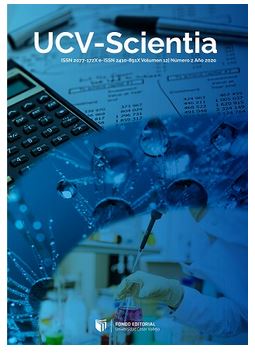Determination of total polyphenols in blueberries and derivatives
DOI:
https://doi.org/10.18050/RevUcv-Scientia.v8n1a1Keywords:
Polyphenols, Blueberries, Antioxidants, Derivatives productsAbstract
Polyphenols are bioactive compounds in plant food. The study of phenolic compounds in food are one of the most developed branches in recent years, of its importance in protecting health, improved nutrition and high antioxidant capacity against the action of free radicals, thus they contribute in preventing diseases. Previous research mentioned that blueberries are fruits high in polyphenols, which has increased its marketing as antioxidants, and this growing demand leads to the formulation of new derivative products, which is the main objective of this work. Fresh blueberries and derived products such as juices, pulp and dried cranberries were analyzed. The results show that the polyphenol content is higher in dehydrated cranberries (1011.5 mg GAE/100g on average) compared to other products tested (379, 358.7 and 234 mg GAE / 100g pulp blueberries, fresh blueberries and juice respectively). It mentioned found that different varieties of blueberries determine the content of phenolic compounds. The blueberries (Vaccinium myrtillus L.) have higher content of polyphenols than red cranberries. It is concluded that blueberries and derived products are an important source of polyphenols, so their consumption is recommended as part of a healthy diet.
Polyphenols are bioactive compounds in plant food. The study of phenolic compounds in food are one of the most developed branches in recent years, of its importance in protecting health, improved nutrition and high antioxidant capacity against the action of free radicals, thus they contribute in preventing diseases. Previous research mentioned that blueberries are fruits high in polyphenols, which has increased its marketing as antioxidants, and this growing demand leads to the formulation of new derivative products, which is the main objective of this work. Fresh blueberries and derived products such as juices, pulp and dried cranberries were analyzed. The results show that the polyphenol content is higher in dehydrated cranberries (1011.5 mg GAE/100g on average) compared to other products tested (379, 358.7 and 234 mg GAE / 100g pulp blueberries, fresh blueberries and juice respectively). It mentioned found that different varieties of blueberries determine the content of phenolic compounds. The blueberries (Vaccinium myrtillus L.) have higher content of polyphenols than red cranberries. It is concluded that blueberries and derived products are an important source of polyphenols, so their consumption is recommended as part of a healthy diet.
Downloads
Published
How to Cite
Issue
Section
License

This work is licensed under a Creative Commons Attribution-NonCommercial 4.0 International License.
- Share — copy and redistribute the material in any medium or format
- Adapt — remix, transform, and build upon the material.
- The licensor cannot revoke these freedoms as long as you follow the license terms.
Under the following terms:
-
Attribution — You must give appropriate credit, provide a link to the license, and indicate if changes were made. You may do so in any reasonable manner, but not in any way that suggests the licensor endorses you or your use.
- No additional restrictions — You may not apply legal terms or technological measures that legally restrict others from doing anything the license permits.













